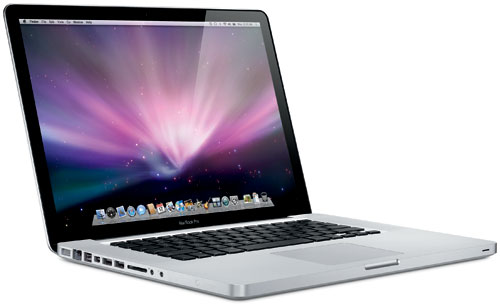Hosted by site sponsor WebMate.
Unibody MacBook Pro Q&A
Published November 11, 2008
All Mac Q&As >> Unibody MacBook Pro Q&A | Also See: All MacBook Pro Specs
To be notified of new Q&As, sign up for EveryMac.com's bimonthly email list.
How much faster is the graphics performance of the "Unibody" MacBook Pro when using the NVIDIA GeForce 9600M GT compared to the NVIDIA GeForce 9400M?
Please note that this Q&A specifically refers to the "Late 2008/Unibody" MacBook Pro models although subsequently introduced MacBook Pro models with dual graphics systems also provide significantly better performance while using the "dedicated" graphics memory rather than the "integrated" graphics (which shares memory with the system). This Q&A is up-to-date and is quite useful for anyone considering one of these models on the used market.
The "Late 2008/Unibody" MacBook Pro models have both a NVIDIA GeForce 9600M GT with dedicated GDDR3 SDRAM and a NVIDIA GeForce 9400M with 256 MB of DDR3 SDRAM shared with main memory.

Photo Credit: Apple, Inc (Late 2008 15-Inch MacBook Pro)
The NVIDIA GeForce 9400M conserves battery life, but provides inferior performance. With general knowledge, one would expect an "integrated" graphics system that "borrows memory from the system" to be substantially slower than a graphics system with dedicated memory, but how much slower only can be unveiled with real-world tests, and most dramatically with games.
Third-Party Graphics Test Results
In a series of gaming tests, MacWorld found:
On the new MacBook Pros the frame rate performance takes a dramatic leap when switching from the 9400M to the 9600M GT. In Doom 3, the frame rate more than doubled when testing at 1,024-by-768, and nearly tripled at 1,280-by-800. In Quake 4, switching from the 9400M to the 9600M GT resulted in a gain of 20 to 30 frames per second. In Unreal Tournament 2004, the gain at 1,024-by-768 is modest, but significant at 1,280-by-854.
As part of an in-depth review, ArsTechnica also hit both graphics processors in the "Unibody" MacBook Pro with a test in Spore:
First, we set the machine to use the integrated GeForce 9400M graphics and loaded up Spore. We cranked the detail settings to the maximum and ran the game at the LCD's native resolution (1440x960). For the next 15 minutes or so, we played through the game's first phase -- an essentially 2D experience where one swims through goo while attacking smaller creatures and avoiding getting eaten by bigger ones. This portion of the game play was extremely fluid and there were no delays or slow-downs.
The 9400 showed its limits however, when the game entered it's second phase. Our creature, quite literally, crawled onto land and we entered a world of sluggish video. The "creature phase" takes place in a much more complex world, with depth-of-field, many 3D characters, and a whole landscape to interact with. . . maximum quality levels at this resolution on the integrated graphics was simply too much.
Next, we switched the computer over to the discrete GeForce 9600M GT card and turned all settings back to their maximum. The 9600, in contrast, handled everything Spore could throw at it.
For Windows games, the MacBook Pro is limited to using its GeForce 9600M GT graphics processor, so there is no other way to test the GeForce 9400M without using it on the "non-Pro" MacBook. Consequently, the Gizmodo blog did exactly that in a "Hardcore Graphics Death Match" and concluded:
Pretty gigantic gap in Crysis performance here. It's a bit more than the 50ish% difference tossed around a few weeks ago when describing the 9600 vs. the 9400, but that's also due to the faster CPU, more RAM and increased L2 cache found in the MacBook Pro. Still, though, you can gauge from the two charts that Crysis is kinda playable on the MacBook on low, and playable on the MacBook Pro on medium. Both are chunktastic on high, and both get slower when you start shooting people in the forest.
Performance Summary
Chunktastic, indeed. Ultimately, the performance of the GeForce 9600M GT is massively superior to the GeForce 9400M, which is best reserved for use when battery life is more important than performance.
Permalink | Report an Error/Typo | Sign Up for Site Update Notices
<< Unibody MacBook Pro Q&A (Main) | Also See: All MacBook Pro Specs
Established in 1996, EveryMac.com has been created by experts with decades of experience with Apple hardware. EveryMac.com includes, and always has included, original research incorporating detailed, hands-on inspection of packaging, computers, and devices as well as extensive real-world use. All information is provided in good faith, but no website or person is perfect. Accordingly, EveryMac.com is provided "as is" without warranty of any kind whatsoever. EveryMac.com, and the authors thereof, shall not be held responsible or liable, under any circumstances, for any damages resulting from the use or inability to use the information within. For complete disclaimer and copyright information please read and understand the Terms of Use and the Privacy Policy before using EveryMac.com. Copying, scraping, or use of any content without expressed permission is not allowed, although links to any page are welcomed and appreciated.
